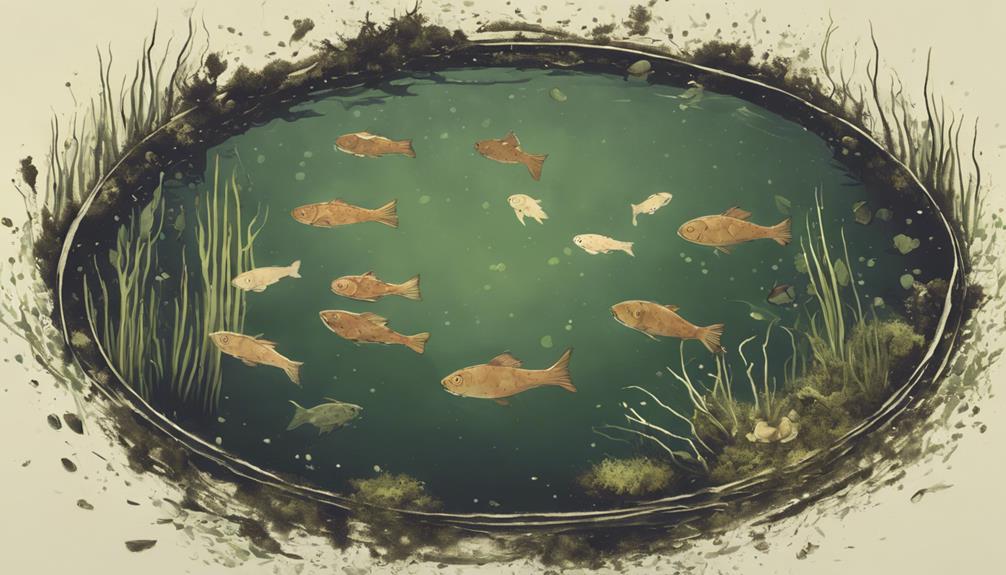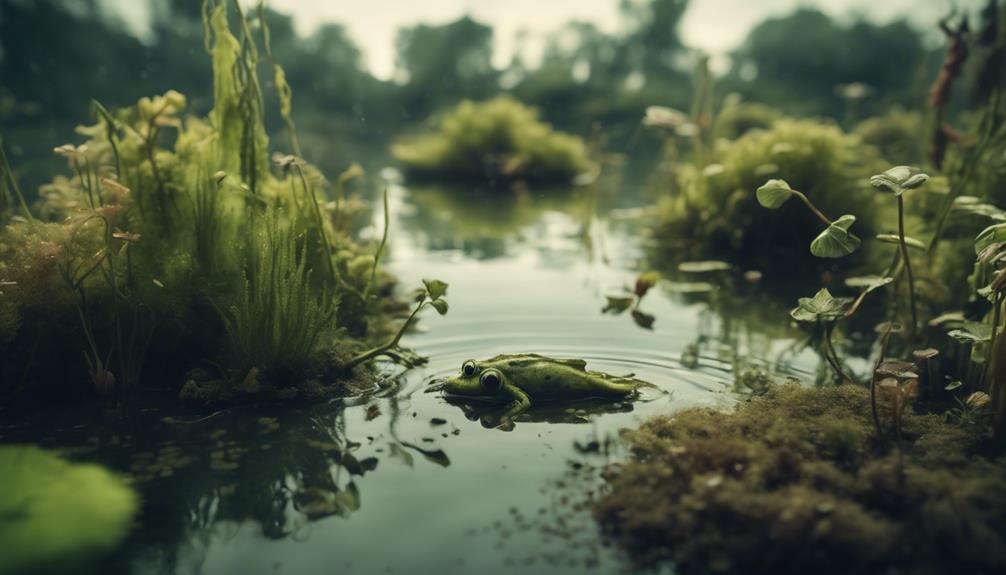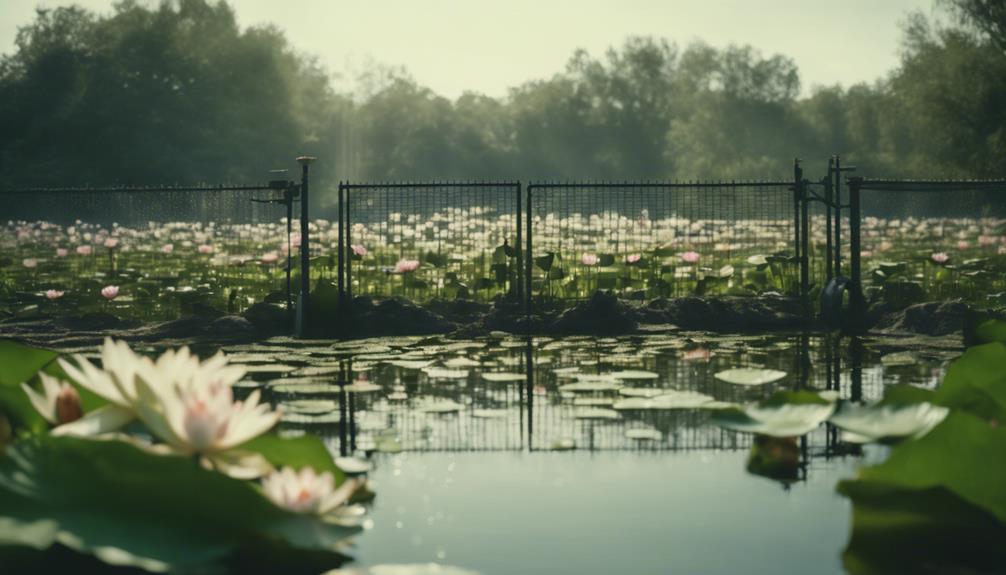When pond oxygen levels drop, you're facing a ticking time bomb that can trigger catastrophic fish kills, devastating your pond's ecosystem and causing long-term damage. Fish suffocate quickly, and entire populations can disappear. Low oxygen levels can also lead to a barren ecosystem, affecting the entire aquatic food chain. Warmer water, excessive algae growth, decaying organic matter, poor water circulation, and nutrient runoff can all cause oxygen levels to plummet. Recognizing the warning signs, such as changes in fish behavior, is vital. Take action now to prevent disaster – and discover the steps you need to take to restore your pond's delicate balance.
Table of Contents
Key Takeaways
- Low oxygen levels can trigger fish kills, leading to significant loss of biodiversity and alteration of food webs.
- Fish suffocate quickly when oxygen levels drop, with the risk of fish kill increasing below 3 parts per million (ppm).
- Decaying organic matter, excessive algae growth, and poor water circulation can cause oxygen depletion, leading to a decline in aquatic life.
- Subtle changes in the ecosystem, such as increased algae growth or shifts in fish behavior, can signal oxygen depletion.
- If left unaddressed, oxygen depletion can lead to long-term damage, including 'dead zones' and disruption of the pond's food chain.
Fish Kill Risks and Consequences
When oxygen levels in your pond drop too low, you risk triggering a fish kill, which can have devastating and far-reaching consequences for the entire aquatic ecosystem.
Fish kills can result in the death of entire fish populations, leading to a significant loss of biodiversity and alteration of food webs. The risk of fish kill increases when oxygen levels drop below 3 parts per million (ppm), and can be catastrophic when levels fall below 1 ppm.
In warm water, oxygen depletion can be particularly severe, resulting in the death of thousands of fish in a short period of time. The consequences of fish kills can be long-lasting, taking years for the ecosystem to recover.
Additionally, fish kills can also result in significant economic losses for fisheries, aquaculture operations, and recreational fishing industries.
In order to prevent this, maintaining good water quality by ensuring adequate oxygen concentrations are available for fish populations to thrive is crucial. By doing so, you can prevent fish deaths and maintain a healthy, balanced ecosystem.
Causes of Low Oxygen Levels
You need to identify the underlying causes of low oxygen levels in your pond to prevent fish kills and maintain a healthy ecosystem, and several factors can contribute to oxygen depletion. Low oxygen water can be a silent killer, and you must understand what causes it.
Some common causes of low oxygen levels in ponds include:
High temperatures: Warm pond water temperatures hold less oxygen than cooler water, making it difficult for fish and other aquatic life to breathe.
Excessive algae growth: Algae consume oxygen at night, reducing the overall oxygen levels in the pond, and excess nutrients that encourage algae growth can exacerbate the issue.
Decaying organic matter: When plants and animals die, they sink to the bottom of the pond and start to decay, consuming oxygen in the process.
Poor water circulation: Stagnant water can lead to low oxygen levels, especially in areas with limited water flow or circulation.
Impact on Aquatic Life

As you explore the impact of low oxygen levels on aquatic life, you'll notice that fish are particularly vulnerable, suffocating quickly when oxygen levels drop.
You'll also observe the rapid appearance of algae blooms, which can further exacerbate the problem.
Meanwhile, invertebrates, such as snails and insects, will disappear fast, leaving behind a barren ecosystem.
Fish Suffocate Quickly
Low oxygen levels in ponds can trigger a rapid decline in fish populations, causing them to suffocate quickly due to the inability of their gills to extract sufficient oxygen from the water.
As you gaze out at your once-thriving pond, you may notice fish swimming erratically near the surface, gasping for air. This is a desperate attempt to find oxygen-rich water, but it's often too late. When oxygen levels drop, fish suffocate quickly, leading to devastating fish kills.
Rapid decline in fish populations: Fish die-offs can occur within hours of oxygen levels dropping.
Erratic swimming behavior: Fish swim near the surface, trying to find oxygen-rich water.
Increased stress: Low oxygen levels cause fish to experience extreme stress, making them more susceptible to disease.
Loss of biodiversity: Fish kills can lead to a loss of biodiversity in your pond, affecting the entire ecosystem.
Algae Blooms Appear
Excessive nutrient runoff from fish waste and decaying organic matter can spark the growth of algae blooms, which further deplete oxygen levels and create a toxic environment for aquatic life.
As you observe your pond, you may notice a sudden surge in algae growth, which can be a telltale sign of oxygen level decline.
Algae blooms can outcompete aquatic plants for essential nutrients, leading to a cascade of negative effects on pond water parameters.
When algae produce excessive amounts of organic matter, it can sink to the bottom of the pond, further depleting oxygen concentration.
This combination of high nutrient levels and low oxygen levels creates an ideal breeding ground for algae blooms.
A Healthy Pond is one where oxygen levels are balanced, and algae growth is kept in check.
However, when oxygen levels drop, algae blooms can quickly take over, pushing your pond further into decline.
Invertebrates Disappear Fast
When you notice a sudden decline in invertebrate populations, it's likely a red flag that your pond's oxygen levels have dropped, putting the entire aquatic food chain at risk. Invertebrates, such as snails, leeches, and crustaceans, are often the first to disappear due to their high oxygen requirements.
A decrease in dissolved oxygen can cause invertebrates to migrate to areas with higher oxygen concentrations, leading to a rapid decline in their populations.
Invertebrates are vital to the aquatic food chain, and their disappearance can have a cascading effect on the entire ecosystem, leading to a decline in fish populations and other aquatic life.
Some invertebrates, such as freshwater mussels, can survive for short periods in low-oxygen conditions, but prolonged exposure can lead to their extinction.
The disappearance of invertebrates can also indicate underlying water quality issues, such as eutrophication or pollution, which can have long-term consequences for the entire ecosystem.
Low oxygen levels can have devastating effects on your pond's ecosystem. It's vital to monitor your pond's oxygen levels and take corrective action to prevent the collapse of the aquatic food chain.
Oxygen Depletion Warning Signs
Frequently, you'll observe subtle changes in your pond's ecosystem that signal oxygen depletion, such as a sudden increase in algae growth or a shift in fish behavior.
As oxygen levels drop, signs of fish distress become apparent. Insufficient oxygen triggers fish to gasp for air at the surface, a desperate attempt to breathe. You might notice sluggish fish swimming near the water's surface, where oxygen is needed most.
Reduced water movement exacerbates the issue, as stagnant water accelerates oxygen depletion.
Other telltale signs of depleted oxygen include a fish die-off, often accompanied by a strong, unpleasant odor. You might also notice an increase in aquatic insects, such as mosquitos, which thrive in low-oxygen environments.
It's essential to monitor your pond's oxygen levels regularly to prevent these warning signs from escalating into a full-blown ecological crisis. By recognizing these subtle indicators, you can take prompt action to restore balance to your pond's ecosystem and ensure the health and well-being of your aquatic inhabitants.
Effects on Ecosystem Balance

As oxygen levels plummet, your pond's delicate ecosystem balance begins to unravel, triggering a cascade of devastating consequences that can have far-reaching impacts on the entire aquatic environment.
With a decreased level of dissolved oxygen, you'll start to notice significant changes throughout your pond's ecosystem.
Low oxygen levels can affect your pond's balance in several ways:
- Fish kills: Low oxygen levels can cause fish to suffocate, leading to massive die-offs that can decimate your pond's fish population.
- Pond plant decline: Oxygen-starved plants struggle to survive, allowing algae to flourish and further deplete the oxygen levels.
- Reduced water circulation: With less oxygen, the water column becomes stagnant, reducing the surface area of water exposed to air and hindering the exchange of oxygen.
- Disrupted nutrient cycles: Low oxygen levels impede the breakdown of organic matter, leading to an accumulation of nutrients that can fuel further algae growth.
As oxygen levels continue to drop, the very fabric of your pond's ecosystem begins to fray.
You must take immediate action to prevent these devastating consequences from spiraling out of control.
Long-Term Damage and Recovery
You must be prepared to face the long-term consequences of prolonged oxygen depletion, which can leave a lasting impact on your pond's ecosystem.
As a pond owner, you need to understand that low oxygen levels can cause long-term damage, including the death of aquatic plants and beneficial bacteria. These losses can take months or even years to recover from.
Fish that survive oxygen depletion may experience stunted growth, increased susceptibility to disease, and reduced fertility, affecting the pond's fish population.
Low oxygen levels can also disrupt the pond's food chain, leading to an overpopulation of species that thrive in low-oxygen conditions, such as certain algae and bacteria. In severe cases, 'dead zones' may form, making it impossible for most aquatic life to survive.
To mitigate long-term damage, you should prioritize regular water testing, aeration, and nutrient management. By committing to these practices, you can accelerate the recovery process and restore your pond's ecosystem.
Preventing Future Oxygen Drops

By taking proactive steps to prevent oxygen depletion, you can safeguard your pond's ecosystem and avoid the devastating consequences of low oxygen levels.
Regular monitoring and testing of your pond's water can help identify oxygen level fluctuations, allowing you to make prompt corrections before it's too late.
To prevent future oxygen drops, consider the following strategies:
- Implement aeration systems, such as air pumps or paddlewheel systems, to increase oxygen levels and reduce the risk of oxygen depletion.
- Manage fish populations through harvesting or relocation to prevent overcrowding, a common cause of oxygen depletion in ponds.
- Maintain a balanced ecosystem by controlling algae growth and introducing oxygen-producing plants, which can help stabilize oxygen levels and prevent future drops.
- Create a thorough pond management plan that takes into account weather patterns, water temperature, and other environmental factors to anticipate and prepare for oxygen level fluctuations.
Frequently Asked Questions
What Would Happen if the Oxygen in a Pond Decreased?
"If you allow oxygen levels in your pond to decrease, you'll disrupt the pond ecosystem, threatening aquatic life, and triggering oxygen depletion, water quality issues, algae blooms, and changes in fish behavior, microbial activity, and the nitrogen cycle."
What Are the Signs of a Lack of Oxygen in a Pond?
You'll notice a stark contrast between a thriving pond and one lacking oxygen, marked by changes in fish behavior, murky water clarity, plant decline, excessive algae growth, and altered insect presence, sediment quality, and aquatic life, all affected by poor water circulation.
What Happens When Dissolved Oxygen Is Low in a Pond?
When dissolved oxygen is low in your pond, you'll notice changes in fish behavior, algae blooms, and decreased water clarity, ultimately impacting aquatic life, bacteria growth, nutrient cycling, sediment release, and even root systems, requiring your prompt attention.
What Happens When Oxygen Levels Are Low in Water?
When you're dealing with low oxygen levels in water, you'll notice fish exhibiting stressed behavior, poor water quality, and harm to aquatic life, which can lead to oxygen depletion, ecosystem disruption, and even algae blooms, impacting water circulation and the nitrogen cycle.
Conclusion
As you gaze out at your seemingly tranquil pond, remember that beneath the surface, oxygen levels can plummet, threatening the very existence of your aquatic ecosystem.
Did you know that a mere 1°C rise in water temperature can decrease oxygen solubility by 2-3%?
This subtle change can have devastating consequences, making it vital to monitor oxygen levels and take proactive measures to prevent drops.
By being informed, you can safeguard your pond's delicate balance and guarantee the health and survival of its inhabitants.

